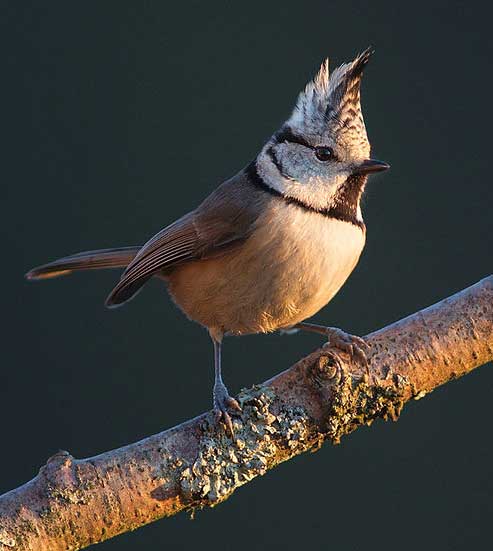
Lophophanes cristatus (*)
Superregnum: Eukaryota
Cladus: Unikonta
Cladus: Opisthokonta
Cladus: Holozoa
Regnum: Animalia
Subregnum: Eumetazoa
Cladus: Bilateria
Cladus: Nephrozoa
Superphylum: Deuterostomia
Phylum: Chordata
Subphylum: Vertebrata
Infraphylum: Gnathostomata
Megaclassis: Osteichthyes
Cladus: Sarcopterygii
Cladus: Rhipidistia
Cladus: Tetrapodomorpha
Cladus: Eotetrapodiformes
Cladus: Elpistostegalia
Superclassis: Tetrapoda
Cladus: Reptiliomorpha
Cladus: Amniota
Classis: Reptilia
Cladus: Eureptilia
Cladus: Romeriida
Subclassis: Diapsida
Cladus: Sauria
Infraclassis: Archosauromorpha
Cladus: Crurotarsi
Divisio: Archosauria
Cladus: Avemetatarsalia
Cladus: Ornithodira
Subtaxon: Dinosauromorpha
Cladus: Dinosauriformes
Cladus: Dracohors
Cladus: Dinosauria
Cladus: Saurischia
Cladus: Eusaurischia
Subordo: Theropoda
Cladus: Neotheropoda
Cladus: Averostra
Cladus: Tetanurae
Cladus: Avetheropoda
Cladus: Coelurosauria
Cladus: Tyrannoraptora
Cladus: Maniraptoromorpha
Cladus: Maniraptoriformes
Cladus: Maniraptora
Cladus: Pennaraptora
Cladus: Paraves
Cladus: Eumaniraptora
Cladus: Avialae
Infraclassis: Aves
Cladus: Avebrevicauda
Cladus: Pygostylia
Cladus: Ornithothoraces
Cladus: Ornithuromorpha
Cladus: Carinatae
Parvclassis: Neornithes
Cohors: Neognathae
Cladus: Neoaves
Cladus: Telluraves
Cladus: Australaves
Ordo: Passeriformes
Subordo: Passeri
Infraordo: Passerida
Familia: Paridae
Genus: Lophophanes
Species: Lophophanes cristatus
Subspecies: L. c. abadiei – L. c. bashkirikus – L. c. bureschi – L. c. cristatus – L. c. mitratus – L. c. scoticus – L. c. weigoldi
Name
Lophophanes cristatus (Linnaeus, 1758)
Synonymy
Parus cristatus (protonym)
References
Linnaeus, C. 1758. Systema Naturae per regna tria naturæ, secundum classes, ordines, genera, species, cum characteribus, differentiis, synonymis, locis, Tomus I. Editio decima, reformata. Holmiæ: impensis direct. Laurentii Salvii. i–ii, 1–824 pp DOI: 10.5962/bhl.title.542: 198. Open access Reference page.
Vernacular names
aragonés: Ferrero de crencha
العربية: قرقف أوروبي ذو عرف
azərbaycanca: Kəkilli arıquşu
башҡортса: Бүрекле тебейек
беларуская: Чубатая сініца
български: Качулат синигер
brezhoneg: Pennglaouig kuch
català: Mallerenga emplomallada
čeština: Sýkora parukářka
чӑвашла: Тĕпекеллĕ кăсăя
Cymraeg: Titw cribog
dansk: Topmejse
Deutsch: Haubenmeise
English: European Crested Tit
Esperanto: Tufparuo
español: Herrerillo capuchino
eesti: Tutt-tihane
euskara: Amilotx mottodun
فارسی: چرخریسک کاکلی
suomi: Töyhtötiainen
français: Mésange huppée
Gaeilge: Meantán cuircíneach
galego: Ferreiriño cristado
magyar: Búbos cinege
հայերեն: Երաշտահավ փուփուլավոր
italiano: Cincia dal ciuffo
日本語: カンムリガラ
қазақша: Айдарлы шымшық
коми: Юрсипыста
lietuvių: Europinė kuoduotoji zylė
latviešu: Cekulzīlīte
македонски: Цуцулеста сипка
кырык мары: Упшан кӹсиӓ
Nedersaksies: Tüüvmeyse
Nederlands: Kuifmees
norsk nynorsk: Toppmeis
norsk: Toppmeis
polski: Czubatka europejska
português: Chapim-de-poupa
română: Pițigoi moțat
русский: Хохлатая синица
slovenčina: Sýkorka chochlatá
slovenščina: Čopasta sinica
svenska: Tofsmes
Türkçe: Tepeli baştankara
татарча / tatarça: Бүрекле песнәк
українська: Синиця чубата
中文: 冠山雀
The crested tit or European crested tit (Lophophanes cristatus) (formerly Parus cristatus), is a passerine bird in the tit family Paridae. It is a widespread and common resident breeder in coniferous forests throughout central and northern Europe and in deciduous woodland in France and the Iberian peninsula. In Great Britain, it is chiefly restricted to the ancient pinewoods of Inverness and Strathspey in Scotland, and seldom strays far from its haunts. A few vagrant crested tits have been seen in England. It is resident, and most individuals do not migrate.
Taxonomy and systematics
This species was formerly placed in Parus, but the distinctness of Lophophanes is well supported,[2] and it is now recognised by the American Ornithologists' Union and the British Ornithologists' Union as a distinct genus.[3]
The current genus name, Lophophanes, is from the Ancient Greek lophos, "crest", and phaino, "to show". The specific cristatus is Latin for "crested".[4]
Behaviour and ecology
It is an easy tit to recognise, for besides its erectile crest, the tip of which is often recurved, its gorget and collar are distinctive. It is, like other tits, talkative, and birds keep up a constant zee, zee, zee birdsongⓘ, similar to that of the coal tit.
It makes a nest in a hole in rotting stumps. This bird often feeds low down in trees, but although not shy, it is not always easily approached. It will join winter tit flocks with other species.
Like other tits it is found in pairs and it feeds on insects (including caterpillars) and seeds.
References
BirdLife International (2016). "Lophophanes cristatus". IUCN Red List of Threatened Species. 2016: e.T22711810A87427182. doi:10.2305/IUCN.UK.2016-3.RLTS.T22711810A87427182.en. Retrieved 19 November 2021.
Gill, Frank B.; Slikas, Beth; Sheldon, Frederick H. (2005). "Phylogeny of titmice (Paridae): II. Species relationships based on sequences of the mitochondrial cytochrome-b gene". Auk. 122: 121–143. doi:10.1642/0004-8038(2005)122[0121:POTPIS]2.0.CO;2.
Sangster, George; Collinson, J Martin; Helbig, Andreas J; Knox, Alan G; Parkin, David T (2005). "Taxonomic recommendations for British birds: third report". Ibis. 147 (4): 821–826. doi:10.1111/j.1474-919X.2005.00483.x.[dead link]
Jobling, James A (2010). The Helm Dictionary of Scientific Bird Names. London: Christopher Helm. pp. 122, 230. ISBN 978-1-4081-2501-4.
External links
Crested tit videos, photos & sounds on the Internet Bird Collection
Song of the crested tit[permanent dead link] (Real Audio soundfile from Sveriges Radio P2)
Ageing and sexing (PDF; 2.3 MB) by Javier Blasco-Zumeta & Gerd-Michael Heinze
Retrieved from "http://en.wikipedia.org/"
All text is available under the terms of the GNU Free Documentation License

